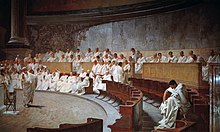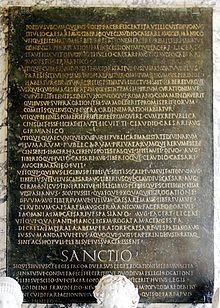Senatus consultum
Senatus consultum ( SC , plural: senatus consulta , German also "Senate Consultation ") was the overriding, constitutional term in the Roman Empire for the result of formal decision-making procedures, which resulted in a decision by the Roman Senate equivalent to the law .
After a deliberative meeting of the senators ( consilium ), the will and the conviction of the senate were summarized in a resolution - the senatus consultum - based on a majority vote by roll call . The result was that an advisory opinion was drawn up on a case that required regulation, including when the committee was involved in the national legislation. The applications of individual persons, usually from magistrates , could on the one hand concern private and on the other hand obligations under public law. In the Roman Republic , in addition to domestic affairs, foreign policy concerns and interests were regularly included in the decision-making process. In the imperial era , after the end of popular legislation, the senatus consulta gradually replaced the leges that had previously been created by popular resolution . Eventually they took their place.
Roman Republic

Before a candidate could apply to the People's Assembly with a request for election or a magistrate about the ratification of a law, the Senate was convened to rule on the matter as an advisory body ( consilium ). Following the majority decision, the applicant received a proposal from the Senate, which, although not legally binding, had a binding commitment based on the mos maiorum due to the prominent position of the Council of Elders in the Roman Republic . The consent required for an election or for legislative proposals marked the following application to the people as approved by the Roman Senate ( auctoritas patrum ). The initial version of the requested matter could be changed in some points by the Senate resolution. The original application points of the magistrate, which were fully taken into account in the Senate resolution, were unofficially referred to as senatus decretum .
Decision-making process

The senators could be called up by the highest magistrates, such as the consuls , praetors and tribunes . The formal notice specified the date, the meeting building in Rome - the Hostilia Curia or a temple - and the rules of procedure for the meeting. The quorum was initially checked by determining the required minimum number of senators on request. Depending on the individual case, half the council of elders or a third of the senators were required to have a quorum. In principle, only senators were allowed to be present during a vote; For the crisis-ridden late period of the republic, cases have been handed down in which attempts were made to prevent the passing of resolutions by taking any citizen off the street to the Curia.
After the quorum had been established, the initiator presented the matter and opened the debate. The floor was given to everyone through the individual survey by name ( interrogatio ). The order was in descending order according to the senators' prestige, rank and age. The esteemed Princeps senatus first gave his opinion and then made his point of view. It was followed by the higher current officials, i.e. the censors , consuls, praetors, and then the curular and plebeian aediles and the tribunes. Then the other members of the Senate, also classified according to their highest position and age, were heard on the matter and asked about their vote. The form of voting ( sententiae ) could be determined by the chairman by moving apart ( discessio ) to the left or to the right.
After the majority had been found, the Senate's decision-making process was embodied in the resolution ( senatus consultum ) and declared effective. The intercession of a public official through his veto during the vote could not prevent the resolution ( auctoritas senatus ) that was passed in spite of this, but the legal effect was partially inhibited or the resolution was not brought before the people.
Decision recording and archiving
The indirect speech recording of the meeting that took place during or after the decision was taken was divided into four sections.
- The preamble contained, in addition to the time and place information, the chairman and his official title as well as the witnesses who were present at the time of writing.
- The subject of negotiation on which the resolution is based.
- The introduction to the resolution.
- The decision taken, either senatus consultum or auctoritas senatus , with the voting mark C for censuere (you have guessed or you have voted).
The senate decisions could be recorded by the scribes on various materials such as stone, wood, bronze or papyrus rolls. They were either kept in the State Archives within the Temple of Saturn or in the Temple of Ceres after systematic registration in annual volumes. If necessary, copies could be made for the public notice.
Senatus consultum ultimum
Not only the patrician officials, but also the plebeian officials were guided by the procedure . In the late and outgoing republic, the populares deliberately omitted to catch up with the senatorial auctoritas senatus in order to be able to more easily assert power-political interests against the optimates .
As a consequence of this political development, the Senate countered with the newly created senatus consultum ultimum . This was intended to counter an impending upheaval in the existing balance of power. The senatorial nobility thus claimed to be able to declare a state of emergency in order to restore public safety and order by suitable means. The consuls were given extraordinary powers so that they could act effectively and legally self-sufficient against the causes of the state of emergency and against those responsible. So it was also possible, in addition to the prohibition of clubs and large-scale deprivation of liberty, which occurred in the Bacchanalia scandal in 186 BC. Were used to carry out executions, as they were on the occasion of the Catilinarian conspiracy in 63 BC. Were enforced without prior legal proceedings. The right of provocation , the appeals to the people for assistance, which every Roman citizen was entitled to as legal protection who was threatened in life and limb by an official act without a judge's judgment, was eliminated by the senatus consultum ultimum . The measures, which in the opinion of the ordering consuls appeared suitable and necessary in the context of the state emergency, could only be legally checked for legality after the end of their term of office and criminal prosecution in the event of violations. The consular Cicero , who was responsible for the execution of state conspirators, was threatened with such a procedure.
Roman Imperial Era

As a result of the principate , the Roman Senate lost its political independence, as the committee, which was still in high regard, was still responsible for various tasks and areas, but ultimately had to submit to the will of the Roman emperors.
The covert powerlessness was particularly evident in the legislative process, where the Senate was apparently able to strengthen its position after the republic. Due to the initial fading and later complete disappearance of the people's legislation, the Senate reports ( senatus consulta ) on the legal inquiries of the magistrates not only had an advisory effect, but also had an indirect legal effect until the 2nd century. This was initially very controversial, because the leges , to which the plebiscites were equal with the strengthening of the concerns of the common people , were of paramount importance in Rome, which is why the binding enforceability ( legis vicem optinere ) of the Senate consuls was initially in question. Since Hadrian at the latest , however, it can be assumed that Senate consuls had functionally replaced the leges . The proposals and inquiries of the praetors were subjected to an expert legal examination and thus at times made an important contribution to the further development of Roman law .
The later direct submissions of the emperors ( oratio principis ) - especially in the Antonine period - which a quaestor read in the Senate , were, without exception, decided as legally valid by a senatus consultum without serious legal discussion . The last testified senate resolution cited as a civil law source, which does not go back to an oratio principis , dates back to 178 ( senatus consultum Orfitianum ). In the 3rd century the senatus consulta completely lost its importance. They were replaced by the ever-evolving, absolute imperial constitutions ( constitutiones principum ). But even the earlier independent petitions of the magistrates had in fact always been dependent on the approval of the emperor.
In essence, the procedure - as it was already handled in the Republic - was retained. The decision recording was expanded to include the applicant, the number of voting senators and their voting behavior.
Senatus consulta
In the area of private law, there are - exemplified - several Senate reports ( senatus consulta ) named by the lawyers after the initiating magistrates, such as that of the legal scholar Pegasus from the years 69-79, who served as praefectus urbi in Rome under Vespasian . The senatus consultum Pegasianum was named after him, which - in addition to a SC Trebellianum from the year 62 - regulated the general application of the universal entailment in Roman law . Other well-known inheritance law SC were
- SC Iuventianum (129); regulated the liability of the estate owner against the tax authorities.
- SC Orfitianum (around 178) and
- SC Tertullianum (between 117 and 138); The latter two SCs regulated the legal succession between mother and child, whereby the inheritance disadvantages of the daughters were improved. With the SC Tertullianum it was even possible to intervene in the provisions of the twelve- table legislation .
From the law of obligations and loans it was those
- SC Hosidianum (44); The SC was already aware of the nullity under civil law, that is, by means of restitutio in integrum, previously valid legal statuses could be restored.
- SC Velleianum (46); served to protect women; they were not allowed to be included in the liability arising from surety, pledging and loan transactions in the interests of third parties.
- SC Macedonianum (between 69 and 79); Prohibition of loan transactions with violent, unauthorized sons of the house who were under the patria potestas .
The SC Silanianum was a criminal investigation that was introduced from 10 AD to help solve the violent death of a Roman householder ( dominus ). In addition, torture measures against slaves were allowed.
With the edicts of the praetors, the imperial representations ( orationes Augusti ) and the imperial constitutions (speeches of the emperor, edicts of the emperor, rescripts , decrees and legal letters of the emperor), the senate reports found their way into the legal sources .
Legal sources
- Gaius , Institutiones 2,256.3; 2,258.3; 2,259.6; 2,286a, 5
- Justinian I. , Digesta Iustiniani 50,16,230, pr.1
- Justinian I., Digesta Iustiniani 32,1,28, pr.1
- Justinian I., Digesta Iustiniani 14,6,1,3,2
literature
- Hans Volkmann : Senatus. In: The Little Pauly (KlP). Volume 5, Stuttgart 1975, column 105 f.
- Hans Volkmann : Senatus consultum. In: The Little Pauly (KlP). Volume 5, Stuttgart 1975, column 109.
- Dieter Medicus : Auctoritas. In: The Little Pauly (KlP). Volume 1, Stuttgart 1964, Col. 729 f.
- Max Kaser : Roman private law . 2nd Edition. CH Beck, Munich / Würzburg 1971, ISBN 3-406-01406-2 , pp. 199, 211, 213, 248, 481, 667, 671, 759-762.
- Max Kaser: Roman legal history. 2nd, revised edition. Vandenhoeck & Ruprecht, Göttingen 1976, ISBN 3-525-18102-7 , pp. 54, 66, 108, 133, 171, 188.
- Wolfgang Kunkel , Martin Schermaier : Roman legal history. 13th edition, Böhlau, Cologne a. a. 2001, ISBN 978-3-8252-2225-3 , pp. 26, 69, 166-167.

